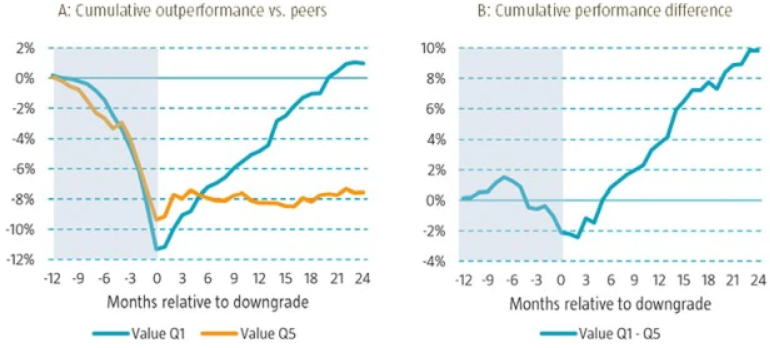The coronavirus pandemic and subsequent demand crisis has led to an unprecedented surge in the number of bonds downgraded from an investment grade rating to high yield (so-called ‘fallen angels’).
For a corporate bond investor, the implication of such a downgrade depends on the perspective. An investment grade investor would consider fallen angels a threat, while a high yield investor would typically view them as an opportunity. In this article we investigate the performance of fallen angels, and show how we are able to distinguish between fallen angels that will subsequently recover and those that will remain weak.
Rating migrations
Rating agencies continually evaluate ratings, potentially leading to an upgrade or downgrade of a company’s rating. The price impact directly after an upgrade or downgrade is usually small, because the change in creditworthiness is priced in beforehand.1 The exception is a rating change that moves a bond from investment grade to high yield, or from high yield to investment grade, because constrained investors are forced to quickly sell their positions. For fallen angels, this mechanism can even lead to serious market inefficiencies, because the supply of fallen angels from the investment grade market is often too large to be efficiently absorbed by the smaller high yield market.
Price patterns of fallen angels
To assess the price pattern of fallen angels, we perform an event study on a 36-month window around the downgrade date, where the window starts 12 months before the downgrade and ends 24 months thereafter. Month 0 marks the point where the bond is downgraded (intra-month) and from month 1 onwards the bond is part of the high yield universe.
Figure 2 shows the results of the event study, averaged over all events in the January 1994 to June 2020 research period. The credit spread of a fallen angel is shown in Panel A and shows a three-phase pattern: widening ahead of the downgrade, inflection around the downgrade date and tightening thereafter. There is not a full recovery, though, owing to the higher risk associated with the acquired high yield rating.
Figure 2 | Fallen angel performance in the period around the downgrade

Source: Robeco, Barclays Bloomberg
Because it is likely that movements in market spreads influence the credit spread pattern, we next compare the returns of fallen angels to peers in terms of credit rating, sector and maturity.2 The cumulative outperformance of fallen angels around the downgrade is shown in Panel B of Figure 2. It shows the same three-phase pattern as Panel A, but inverted (as returns and spreads move in opposite directions). Fallen angels underperform their peers a few quarters before the event; especially in the last quarter, and most strongly in the month of the downgrade, when the forced selling of constrained investors pushes the price down even further. Thereafter, relative performance turns positive and stays positive for up to 24 months after the downgrade, as high yield investors start buying the fallen angels and the downgraded companies start taking measures to repair their creditworthiness.
This performance pattern indicates that selling a bond directly after the downgrade is likely to be the worst possible moment to do so.
Enhanced fallen angel investing with the Value factor
Given the above results, the question arises whether an investor should simply buy all fallen angels, or if there is a way to distinguish between fallen angels that subsequently recover and those that don’t.
This is where our extensive experience with the value factor comes into play, as it is used to identify the attractiveness of corporate bonds given their risk. In other words, it assesses whether a bond is attractively priced (‘cheap’), or not (‘expensive’).3 To test the ability of the value factor to select the ‘right’ fallen angels, we compare the performance of fallen angels with high value scores in the month after the downgrade (top quintile, ‘Q1’) to the performance of fallen angels with low value scores (bottom quintile, ‘Q5’).
Panel A in Figure 3 shows the cumulative outperformance against peers for these cheap and expensive fallen angels, according to our value factor; Panel B shows the performance difference between the two groups. The cheap fallen angels (Value Q1, blue line) underperform more until the downgrade, after which they start to considerably outperform the more expensive fallen angels (Value Q5, orange line). In fact, the cheap fallen angels perform so well after the downgrade that the event window-return turns positive.
The expensive fallen angels, on the other hand, do not experience much of a reversal at all. So instead of buying all fallen angels indiscriminately, by using our value factor, we can discern outperforming from underperforming fallen angels.
Figure 3 | Fallen angel performance breakdown by Value factor score

Source: Robeco, Barclays Bloomberg
Conclusion
Our Multi-Factor Credits and Multi-Factor High Yield strategies invest in fallen angels based on their attractiveness from a factor perspective. This research reinforces our belief that the bottom-up approach to investing in our multi-factor credit strategies is warranted.
クレジットの最新動向は?
クレジット運用の最新情報を先取りするニュースレター(英文)に登録しましょう。
Footnotes
1See e.g. Norden, Weber, 2014, “Informational Efficiency of Credit Default Swap and Stock Markets: The Impact of Credit Rating Announcements”, Journal of Banking & Finance
2To construct the peer groups, we use the methodology of Ben Dor and Xu, 2011, “Fallen Angels: Characteristics, Performance, and Implications for Investors”, Journal of Fixed Income; peer groups are defined based on industry (financials, industrials, and utilities) and credit quality (A and higher, BBB, BB, B, and CCC and lower); in addition, with the exception of the lowest credit-quality category, separate buckets are constructed for short/intermediate and long maturity bonds (up to ten years and above ten years, respectively), resulting in a total of 27 peer groups.
3See our 2016 white paper “Smart Credit Investing: The Value Factor”.
重要事項
当資料は情報提供を目的として、Robeco Institutional Asset Management B.V.が作成した英文資料、もしくはその英文資料をロベコ・ジャパン株式会社が翻訳したものです。資料中の個別の金融商品の売買の勧誘や推奨等を目的とするものではありません。記載された情報は十分信頼できるものであると考えておりますが、その正確性、完全性を保証するものではありません。意見や見通しはあくまで作成日における弊社の判断に基づくものであり、今後予告なしに変更されることがあります。運用状況、市場動向、意見等は、過去の一時点あるいは過去の一定期間についてのものであり、過去の実績は将来の運用成果を保証または示唆するものではありません。また、記載された投資方針・戦略等は全ての投資家の皆様に適合するとは限りません。当資料は法律、税務、会計面での助言の提供を意図するものではありません。 ご契約に際しては、必要に応じ専門家にご相談の上、最終的なご判断はお客様ご自身でなさるようお願い致します。 運用を行う資産の評価額は、組入有価証券等の価格、金融市場の相場や金利等の変動、及び組入有価証券の発行体の財務状況による信用力等の影響を受けて変動します。また、外貨建資産に投資する場合は為替変動の影響も受けます。運用によって生じた損益は、全て投資家の皆様に帰属します。したがって投資元本や一定の運用成果が保証されているものではなく、投資元本を上回る損失を被ることがあります。弊社が行う金融商品取引業に係る手数料または報酬は、締結される契約の種類や契約資産額により異なるため、当資料において記載せず別途ご提示させて頂く場合があります。具体的な手数料または報酬の金額・計算方法につきましては弊社担当者へお問合せください。 当資料及び記載されている情報、商品に関する権利は弊社に帰属します。したがって、弊社の書面による同意なくしてその全部もしくは一部を複製またはその他の方法で配布することはご遠慮ください。 商号等: ロベコ・ジャパン株式会社 金融商品取引業者 関東財務局長(金商)第2780号 加入協会: 一般社団法人 日本投資顧問業協会



















